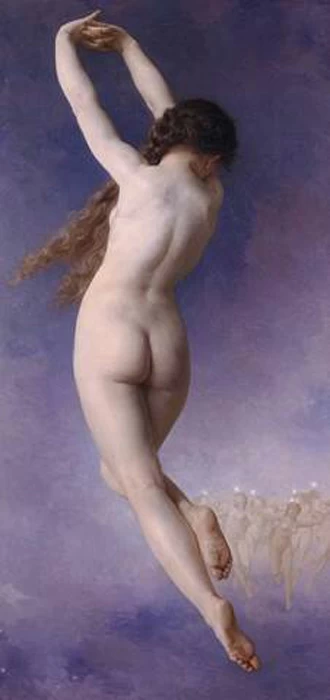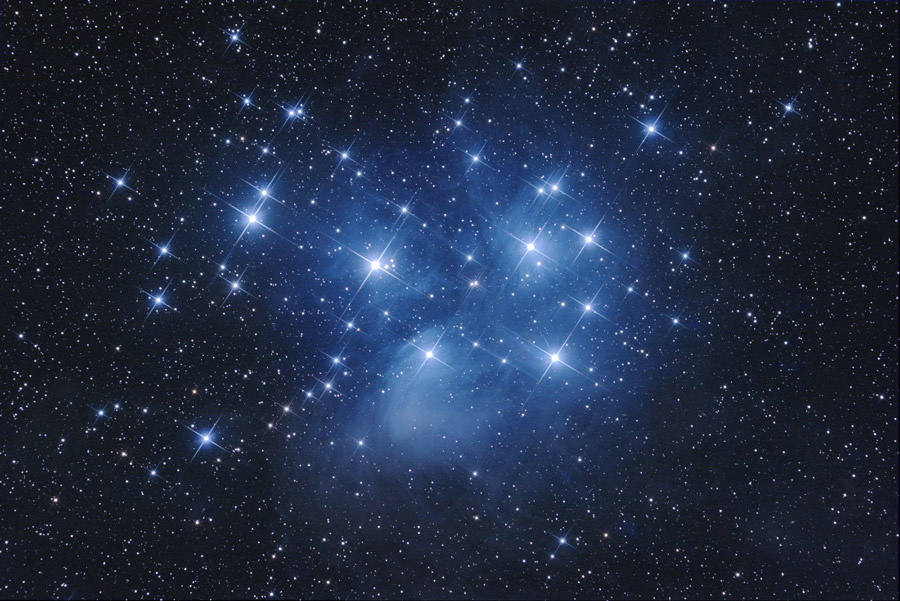The Pleiades, a bright cluster of stars, forms one of the most familiar objects in the night sky. Known to the ancients across the world wherever the star cluster is easily visible, they are also known as The Seven Sisters.
Many legends and myths existed in almost every culture of the planet at some point in time. Tales about the Seven Sisters have been passed on from generation to generation through word-of-mouth, art, poetry, architecture and music. The Indians, Persians, Egyptians, Chinese, Greeks, Aborigines and Native Americans had their own versions of the story, woven into their mythos.
They are depicted on the Nebra Sky Disc, and mentioned three times in the Hebrew Bible (where they are referred to as “Khima”). Cultures as disparate as the ancient Greeks and the Aztecs revered the sisters.
The Chinese knew of the star cluster over 4,000 years ago, and the Japanese refer to the stars as “Subaru” and use their image as the badge of the car manufacturer they are named for. And it is here, strangely, that the strange contradiction at the heart of the Pleiades can be most clearly seen.
For the badge on a Subaru car, modelled after the Pleiades, has only six stars. Similarly, if you were to look up at the night sky you would only see six stars in the cluster, not seven.

So, why did so many unconnected and geographically distant cultures claim there were seven stars in the Pleiades? Where is the seventh sister?
Known to the Ancients
The Pleiades, along with the constellation Orion who pursues them across the sky, are the first stars mentioned in ancient writings. These stars appeared in Chinese annals as far back as 2350 BC, and the earliest surviving reference in European literature comes from a poem by Hesiod around 700 BC.
Humankind has always looked to the night sky, with its intangible and mysterious stars, to seek guidance. The Pleiades, clustered so closely together and shining so brightly, were an obvious and attractive focal point for ancient stargazers.
- How Did The Dogon Tribe Know About Sirius B?
- “And Yet It Moves” – Galileo, the Planets, and the Church
Sailors in the deep sea relied on the stars, and particularly on familiar and easily seen reference points, for their navigation. Farmers used the Pleiades to decide the right time to sow their seeds, and the ideal time to harvest the crops. The Zuni Tribe in New Mexico even referred to them as the “seed stars”.
From the Greeks we even have the names of the seven sisters of the Pleiades, and here we have our first clue in unravelling this mystery. The sisters were called Maia, Alcyone, Merope, Asterope, Calaeno, Taygete, and Electra.
Maia is the eldest sister and stands apart, famed for her beauty and solitary life. Alcyone was the second sister in Greek mythology and was the leader of all the sisters. She was the watcher over the Mediterranean Sea, making it safe and calm for the sailors.
Asterope translates to “starry faced” and is traditionally portrayed as one of the weak sisters. Celaeno is named for her swarthiness and similarity to a melon, and like Asterope shines with less brightness than that the others.
Taygete or “Tiggy” in the myths is just like Maia, who had intense value upon their independence, and lived within the mountains. Electra is the third brightest star.
All of these stars can be identified today, and this leaves the star that is lost: the seventh star, Merope. This star is termed the “lost Pleiad” because it was the last star mapped by ancient astronomers. Moreover, it is also the faintest star within the cluster and is only barely visible to the naked eye.
Merope the Lost Star
The inclusion of Merope is at first a puzzle. Ther are many other stars which surround the Pleiades which are excluded despite being visible, and her inclusion alongside her brighter sisters seems odd.
Perhaps the Greeks who names her offer the answer in her mythology. Daughter of the Greek titan Atlas, who held the sky on his shoulders, she shamed her lineage and family by being the only member of the Pleiades to marry a mortal.
While her sisters married gods of the Greek pantheon, Merope married an earthly king, Sisyphus. Her shame at such a lowly union caused her to cover herself in the night sky, becoming barely visible.
- Narcissus Myth: Early Poets and the Ancient Story
- Outrageous Astronomy – Who Was Behind The Great Moon Hoax of 1835?
Another myth tells of the punishment meted out to Sisyphus by the gods. For betraying Zeus and tricking Thanatos, the Greek god of death, into a trap, Sisyphus was condemned to eternal punishment in the Greek underworld, endlessly rolling a boulder up a hill as a twisted version of her father.

Merope travelled with her cursed husband into the underworld, choosing to remain with him even after death. The darkness of Hades surrounded her and she was dimmed in the night sky as a result.
A Lost Sister for Many Cultures
There are many similar stories about the “Lost Pleiad” written across the globe. Indonesian, Native American, African, European, and Australian cultures all have their own stories about the inclusion of the seventh sister, and why she is so hidden compared to the others.
So it would seem that under this puzzle there is another, and the inclusion of the seventh, invisible sister in so many legends defies easy explanation. Is there some hidden link between these scattered civilizations which emphasizes the shadowy seventh sister?
Perhaps her inclusion signals that a culture has reached a certain level of sophistication, in being able to discern the almost invisible Merope. Such cultures, which have advanced to this point, are more likely to leave traces behind for us to find.
Dance of the Seven Sisters
There is also another, perhaps more grounded explanation to consider. The seven sisters like the rest of the night sky, are not static: they engage in a dance with each other, slow and beautiful.
Modern astronomical observations have allowed scientists to piece together the history of this dance, going back as far as 100,000 years ago. Their conclusion is unequivocal: the stars have moved, and would have looked different to the ancients than they do today.
This change, combined with a night sky free from light pollution, may have allowed ancient stargazers to see the seven stars of the cluster, even hidden Merope. She may have been wreathed in shadow, but clearly she was more visible in past centuries than she currently is.
Perhaps her shame, or the underworld prison she willingly trapped herself in, has only grown more powerful with time. Would the Greeks have known this, and seen her fade slowly from their view?
Top Image: Why “seven” sisters? Source: Yavdat / Adobe Stock.
By Bipin Dimri
